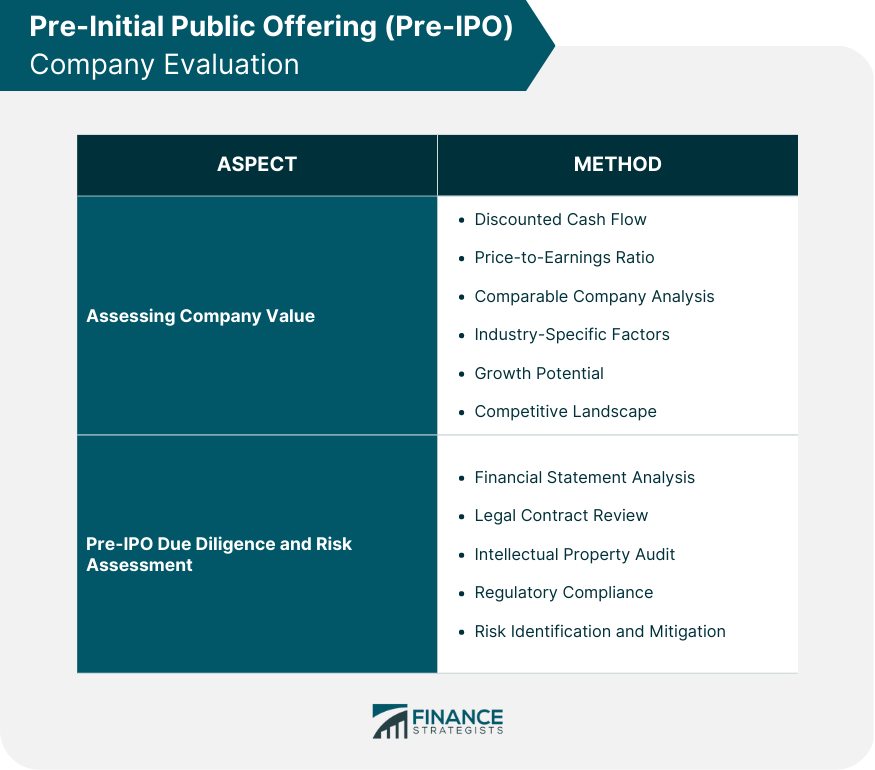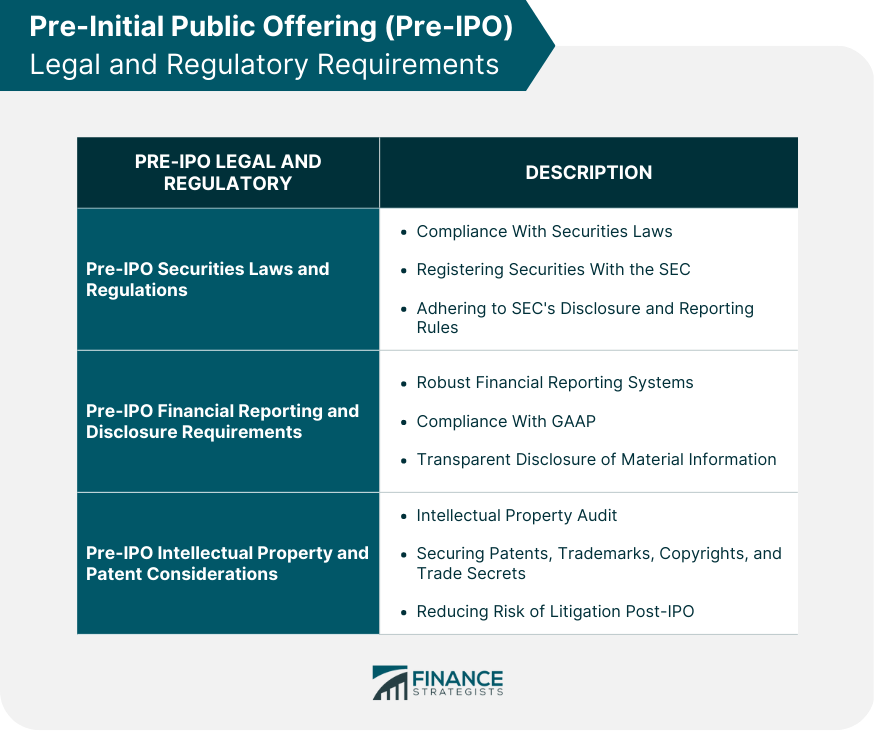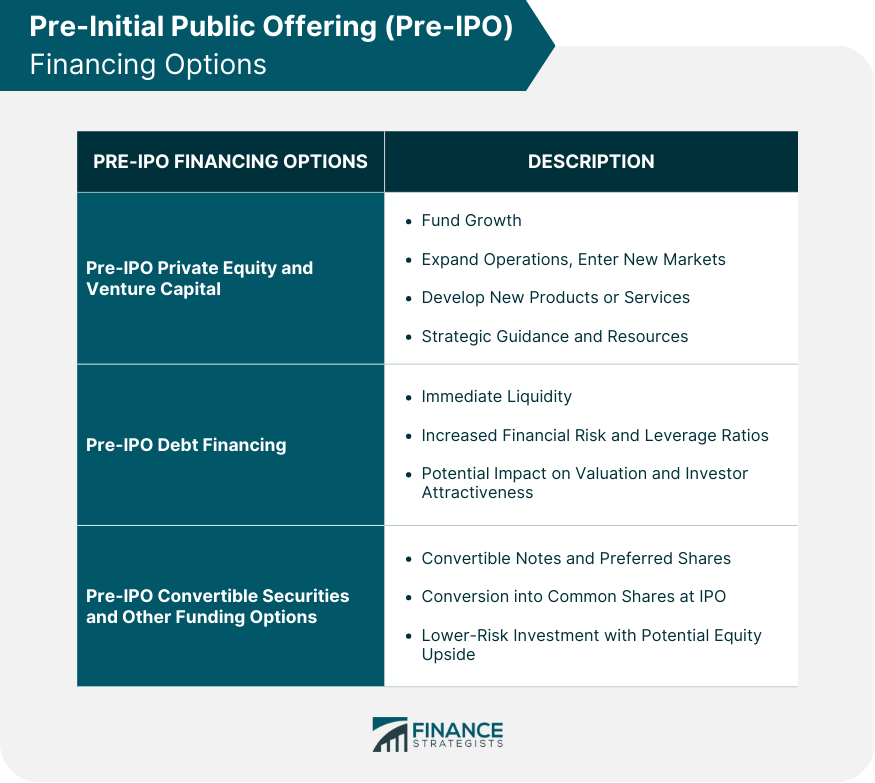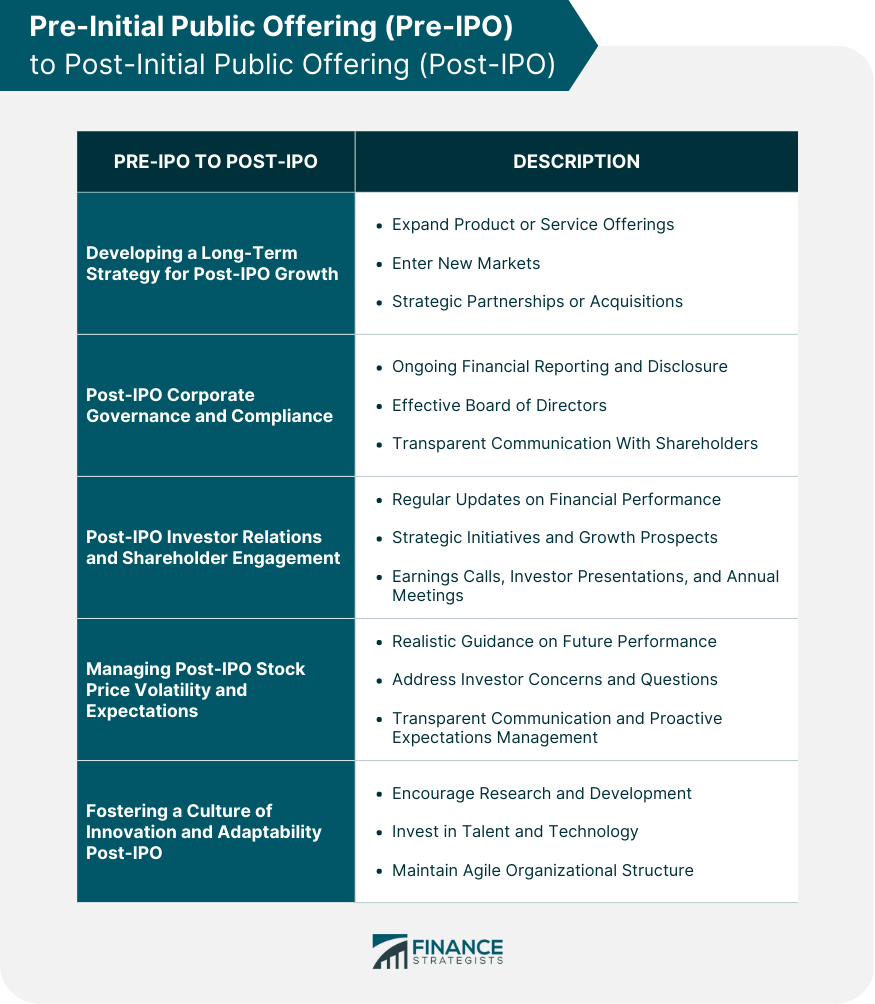The Pre-Initial Public Offering stage refers to the period in a company's life cycle before it goes public through an Initial Public Offering (IPO). During this time, the company prepares itself for an IPO by addressing various financial, operational, legal, and regulatory requirements. The Pre-IPO stage plays a crucial role in ensuring the success of the IPO and the company's smooth transition into a publicly traded entity. The Pre-IPO phase is essential for several reasons. It allows the company to build a strong foundation, streamline operations, ensure legal and regulatory compliance, and establish a solid corporate governance structure. It helps the company attract investors and generate interest in the upcoming IPO. Adequate preparation during the Pre-IPO phase can increase the chances of a successful IPO and a better valuation in the public market. In the Pre-IPO stage, it's crucial to assess the company's value to determine the appropriate IPO pricing and to attract investors. This valuation can be done through various methods, including discounted cash flow, price-to-earnings ratio, and comparable company analysis. It's essential to consider industry-specific factors, growth potential, and the competitive landscape when evaluating the company's worth. Conducting thorough due diligence and risk assessment is vital during the Pre-IPO phase. This process involves analyzing the company's financial statements, legal contracts, intellectual property, and compliance with regulatory requirements. Identifying and addressing potential risks can help the company mitigate potential roadblocks during the IPO process and ensure a smoother transition to the public market. A robust management team is vital for a successful Pre-IPO process. The company should assemble a team of experienced professionals with expertise in finance, operations, legal, and regulatory matters. This team should be capable of guiding the company through the complex IPO process and communicating effectively with investors and regulators. Creating a comprehensive business plan and financial model is crucial during the Pre-IPO phase. The business plan should outline the company's growth strategy, target market, competitive landscape, and revenue projections. The financial model should provide a detailed analysis of the company's historical and projected financial performance, including income statements, balance sheets, and cash flow statements. These documents help investors understand the company's prospects and potential return on investment. Establishing sound corporate governance practices and an effective board of directors is vital during the Pre-IPO stage. The board should consist of a mix of experienced executives and independent directors who can provide valuable insights and unbiased guidance. Implementing strong corporate governance policies can enhance investor confidence and contribute to the company's long-term success. Complying with securities laws and regulations is critical during the Pre-IPO phase. The company should consult with legal and financial advisors to ensure it meets all the necessary requirements, including registering the securities with the Securities and Exchange Commission (SEC) and adhering to the SEC's disclosure and reporting rules. Accurate financial reporting and transparent disclosure are essential during the Pre-IPO stage. The company should implement robust financial reporting systems and internal controls to ensure compliance with the Generally Accepted Accounting Principles (GAAP) and other applicable standards. Transparent disclosure of material information, including financial performance, business risks, and management's discussion and analysis, can help build investor trust and confidence. Protecting the company's intellectual property (IP) is crucial during the Pre-IPO phase. The company should conduct an IP audit to identify and secure its patents, trademarks, copyrights, and trade secrets. Ensuring proper IP protection can enhance the company's value and reduce the risk of litigation post-IPO. Raising capital through private equity and venture capital is common for companies to fund their growth during the Pre-IPO stage. These investments can help the company expand its operations, enter new markets, and develop new products or services. Additionally, partnering with experienced investors can provide valuable strategic guidance and resources. Debt financing, such as loans and bonds, is another option for companies to raise capital in the Pre-IPO stage. While debt financing can provide immediate liquidity, it may also increase the company's financial risk and leverage ratios, potentially impacting its valuation and attractiveness to public investors. Convertible securities, such as convertible notes and preferred shares, are another financing option for Pre-IPO companies. These securities can convert into common shares upon certain triggers, such as the company's IPO. Convertible securities can offer investors a lower-risk investment with the potential for equity upside while providing the company with much-needed capital during the Pre-IPO phase. Roadshows and investor presentations are essential marketing tools during the Pre-IPO stage. These events allow the company to showcase its business strategy, financial performance, and growth prospects to potential investors. Effective roadshows and presentations can generate interest in the IPO and help establish a strong investor base. Targeting the right investors and building a diverse shareholder base is crucial during the Pre-IPO phase. The company should identify and engage with institutional investors, high-net-worth individuals, and retail investors who will likely be interested in its IPO. A well-balanced shareholder base can contribute to the company's long-term stability and success in the public market. A strategic public relations and media campaign can help raise awareness about the company and its upcoming IPO. The company should engage with journalists, influencers, and industry analysts to share its story and achievements. A positive media presence can enhance the company's reputation and contribute to the success of the IPO. Several key events and decision points during the Pre-IPO phase include selecting underwriters, filing the IPO registration statement, and setting the IPO price range. The company should plan and execute these events carefully to ensure a smooth IPO process. The Pre-IPO timeline can vary depending on the company's size, industry, and specific circumstances. Generally, the Pre-IPO process can take anywhere from several months to a few years. Developing a realistic timeline and incorporating sufficient contingencies can help the company stay on track and minimize potential delays. Regularly tracking and monitoring the company's progress toward Pre-IPO milestones is essential for maintaining momentum and ensuring the timely completion of the IPO process. The company should establish a system for tracking key milestones, assigning responsibilities, and communicating progress updates to relevant stakeholders. This approach can help identify potential bottlenecks or issues and enable prompt resolution. Various challenges, such as regulatory changes, market volatility, and unforeseen operational issues, can arise during the Pre-IPO phase. Identifying these potential roadblocks early in the process can help the company develop mitigation strategies and minimize the impact on the IPO timeline. Managing risks and uncertainties is crucial during the Pre-IPO stage. The company should develop a comprehensive risk management plan that addresses various risks, including financial, operational, legal, and reputational risks. Implementing effective risk mitigation measures can increase the likelihood of a successful IPO and contribute to the company's long-term stability. Having contingency plans can help the company navigate unexpected challenges or crises during the Pre-IPO phase. These plans should include alternative financing options, communication strategies, and operational adjustments to ensure the company remains on track for its IPO. Developing a robust crisis management plan can also help protect the company's reputation and investor confidence in the face of adversity. Once the company has completed the Pre-IPO preparation, it's time to transition to the actual IPO process. This transition involves finalizing the IPO pricing, allocating shares to investors, and listing the company's shares on a stock exchange. The company should work closely with its underwriters, legal advisors, and financial advisors to ensure a smooth transition and a successful IPO. After the IPO, the company must reflect on its Pre-IPO journey and identify lessons learned and best practices. This reflection can help the company improve its processes, strategies, and decision-making in the future. Sharing these insights with other companies considering an IPO can contribute to the broader ecosystem's knowledge and success. Conducting a post-mortem analysis of the Pre-IPO process can help the company evaluate its performance and identify areas for improvement. This analysis should include reviewing the company's financial performance, operational efficiency, and investor relations. Gaining insights from this analysis can enable the company to make informed decisions and enhance its long-term success in the public market. Following a successful IPO, the company should focus on long-term growth and shareholder value creation. This strategy should encompass expanding the company's product or service offerings, entering new markets, and pursuing strategic partnerships or acquisitions. A well-executed long-term strategy can help the company maintain its competitive advantage and deliver strong returns to shareholders. Maintaining strong corporate governance and compliance practices becomes even more critical as a publicly traded company. The company must adhere to ongoing financial reporting and disclosure requirements, maintain an effective board of directors, and ensure transparent communication with shareholders. Robust corporate governance and compliance practices can help protect the company from potential legal or regulatory issues and enhance its reputation in the public market. Continued investor relations and shareholder engagement are essential to maintaining a stable and supportive investor base post-IPO. The company should regularly update investors on its financial performance, strategic initiatives, and growth prospects through earnings calls, investor presentations, and annual meetings. Effective investor relations can help build trust, loyalty, and long-term support from the investor community. Following the IPO, the company's stock price may experience volatility as it responds to market forces and investor sentiment. The company should manage investor expectations by providing realistic guidance on its future performance and addressing any concerns or questions from the investment community. Transparent communication and proactive expectations management can help stabilize the stock price and maintain investor confidence. To ensure long-term success in the public market, the company must foster a culture of innovation and adaptability. Encouraging research and development, investing in talent and technology, and maintaining an agile organizational structure can help the company stay ahead of industry trends and competitors. Cultivating this culture can drive sustained growth and value creation for shareholders in the years following the IPO. Navigating the Pre-IPO process is crucial for companies preparing to enter the public market. This comprehensive guide covers essential aspects such as company evaluation, planning and strategy, legal and regulatory compliance, financing, marketing, and investor relations. It also highlights the importance of addressing challenges and risks and ensuring a smooth transition to the IPO process. After the IPO, companies must focus on long-term growth, robust corporate governance, and fostering a culture of innovation and adaptability. Consider seeking professional wealth management services to optimize your investment portfolio and capitalize on Pre-IPO opportunities. These experts can help you identify promising Pre-IPO companies, provide tailored investment advice, and guide you through the complexities of investing in the public market.What Is a Pre-Initial Public Offering (Pre-IPO)?
Importance of the Pre-IPO Phase
Pre-IPO Company Evaluation
Assessing Company Value in the Pre-IPO Stage
Pre-IPO Due Diligence and Risk Assessment

Pre-IPO Planning and Strategy
Building a Strong Pre-IPO Management Team
Developing a Pre-IPO Business Plan and Financial Model
Pre-IPO Corporate Governance and Board Composition
Pre-IPO Legal and Regulatory Requirements
Pre-IPO Securities Laws and Regulations
Pre-IPO Financial Reporting and Disclosure Requirements
Pre-IPO Intellectual Property and Patent Considerations

Pre-IPO Financing Options
Pre-IPO Private Equity and Venture Capital
Pre-IPO Debt Financing
Pre-IPO Convertible Securities and Other Funding Options

Pre-IPO Marketing and Investor Relations
Pre-IPO Roadshows and Investor Presentations
Pre-IPO Investor Targeting and Shareholder Base Building
Pre-IPO Public Relations and Media Strategy
Pre-IPO Timeline and Milestones
Key Pre-IPO Events and Decision Points
Estimating the Pre-IPO Timeline
Pre-IPO Milestone Tracking and Progress Monitoring
Pre-IPO Challenges and Risks
Identifying Potential Pre-IPO Roadblocks
Mitigating Pre-IPO Risks and Uncertainties
Pre-IPO Contingency Planning and Crisis Management
Post-Pre-IPO Transition
Transitioning From Pre-IPO to the IPO Process
Pre-IPO Lessons Learned and Best Practices
Pre-IPO Post-Mortem and Performance Analysis
Pre-IPO to Post-IPO: Long-term Strategy and Growth
Developing a Long-Term Strategy for Post-IPO Growth
Post-IPO Corporate Governance and Compliance
Post-IPO Investor Relations and Shareholder Engagement
Managing Post-IPO Stock Price Volatility and Expectations
Fostering a Culture of Innovation and Adaptability Post-IPO

Final Thoughts
Pre-Initial Public Offering (Pre-IPO) FAQs
A Pre-IPO refers to the stage before a company goes public through an Initial Public Offering (IPO). During this period, the company prepares for the IPO by addressing various financial, operational, legal, and regulatory requirements.
The Pre-IPO phase is essential because it allows the company to build a strong foundation, streamline operations, ensure legal and regulatory compliance, establish a solid corporate governance structure, and attract investors, ultimately increasing the chances of a successful IPO and better valuation in the public market.
Common Pre-IPO financing options include private equity and venture capital investments, debt financing (loans and bonds), and convertible securities (such as convertible notes and preferred shares).
The Pre-IPO timeline can vary depending on the company's size, industry, and specific circumstances. Generally, the Pre-IPO process can take anywhere from several months to a few years.
A company can ensure a smooth transition from the Pre-IPO to the IPO process by carefully planning and executing key events, working closely with underwriters, legal advisors, and financial advisors, and maintaining strong corporate governance and compliance practices throughout the process.
True Tamplin is a published author, public speaker, CEO of UpDigital, and founder of Finance Strategists.
True is a Certified Educator in Personal Finance (CEPF®), author of The Handy Financial Ratios Guide, a member of the Society for Advancing Business Editing and Writing, contributes to his financial education site, Finance Strategists, and has spoken to various financial communities such as the CFA Institute, as well as university students like his Alma mater, Biola University, where he received a bachelor of science in business and data analytics.
To learn more about True, visit his personal website or view his author profiles on Amazon, Nasdaq and Forbes.











